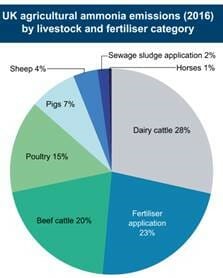In the UK, agricultural emissions account for 88% of our total ammonia emissions. These emissions are increasing for the fourth consecutive year, meaning the previous target set for 2020 of an 8% reduction is now unlikely to be met. Half of all ammonia emissions are produced by cattle farming[1]. To understand the concern about ammonia emissions we will examine the source of ammonia and what should be done now to protect human and environmental health.
The rise of intensively farmed animals means that, in some parts of the UK, animals outnumber humans. The high demand for low-cost meat is driving the rapid increase in intensive livestock farming, which are the largest emitters of ammonia. Like in Herefordshire, where there are 88 livestock for every 1 person. Livestock housed in these intensive farms produce manure and slurry which release large quantities of ammonia directly into the atmosphere. Livestock farming also releases large quantities of methane and nitrous oxides, two very powerful Greenhouse Gases. Additionally, runoff of agricultural fertilizers, pesticides and slurry can impact water resources in a community.
Odour, dust and noise emissions are another nuisance that erode public amenity around livestock farms. The Environment Agency reports that they respond to around 700 pollution incidents on farms each year. Emma Howard Boyd, chair of the Environment Agency, said in a May 8, 2018 article for The Times that:
“Agriculture is one of the biggest sources of serious pollution incidents bad farming is a slow-motion environmental catastrophe. It pollutes our watercourses and the air we breathe and it damages the habitats on which wildlife depends.”
UK Agricultural Ammonia Emissions
In the UK, pig and poultry farms are responsible for 22% of agricultural emissions, whilst beef and dairy cattle farms carry a whopping 48%. Despite the proportionally large impact of intensive cattle farming, emissions to air, water and land are still not regulated by the Environment Agency’s permitting system. The only livestock farming activities regulated under the Environmental Permitting Regulations are pig and poultry rearing farms that are above a certain threshold of animal places (40,000 places for poultry or 2,000 places for production pigs and 750 for sows). Due to a lack of resources and staff cutbacks, the agency is already struggling to monitor and enforce the pig and poultry regulations. It is doubtful that they will have the capacity to regulate cattle farms in the near future.

Although ammonia itself has a short lifetime in the atmosphere (1-3 hours), PM2.5 has a much longer lifetime (1-3 days). This allows long-range transport of PM2.5 and a wider geographic distribution, meaning that cities as far as kilometers away can be affected by ammonia emissions from agricultural areas.
Ecological Impact
The ecological impacts of ammonia exposure can also be severe. Atmospheric ammonia contributes up to 80% of total nitrogen deposition,[2] affecting sensitive terrestrial and aquatic habitats across the UK; 63% of all habitats in the UK are affected by excessive nitrogen deposition.
Nitrogen accumulation on plant species diversity and composition results in a major effect on biodiversity. Ammonia impacts species composition through soil acidification, direct toxic damage to leaves and by altering the plants’ tolerability to physical, chemical and biological factors such and frost, drought, pests and invasive species.
The government has finally acknowledged the impact of the agriculture industry on air quality in their latest Clean Air Strategy 2019, which detailed measures to control emissions from farming, including:
- An environmental land management system to fund targeted action to protect ammonia-impacted habitats;
- A reduction in ammonia emissions from farming by requiring the adoption of low emissions farming techniques; and
- An extension of environmental permitting to intensive dairy and beef farms by 2025.
Unfortunately, the proposed 2025 implementation of environmental permitting for intensive cattle farming is too late. Given the significant impact of cattle farming on the environment, all dairy and beef farms should be regulated now, regardless of their size and the implementation date should be brought forward to prevent even more damage to human health and biodiversity.
For air quality assessments for environmental planning or permitting in the UK farming sector, please contact Sherif Hassan.
Cited Sources
- [1]https://assets.publishing.service.gov.uk/government/uploads/system/uploads/attachment_data/file/729646/code-good-agricultural-practice-ammonia.pdf
- [2] https://doi.org/10.1111/j.1469-8137.1993.tb03882.x
- The Bureau of Investigative Journalism. The Rise of the “Megafarm”: How British Meat is Made. 17/07/2017.
- Pozzer, A., Tsimpidi, A. P., Karydis, V. A., de Meij, A., and Lelieveld, J.: Impact of agricultural emission reductions on fine-particulate matter and public health, Atmos. Chem. Phys., 17, 12813-12826, https://doi.org/10.5194/acp-17-12813-2017, 2017.
- Defra; Scottish Government; Welsh Government; and Department of the Environment in Northern Ireland. Air Quality Expert Group. Air Pollution from Agriculture. 2018.
- https://www.theguardian.com/environment/2019/jun/13/revealed-uk-government-failing-to-tackle-rise-of-ammonia-serious-air-pollutant
- https://royalsociety.org/~/media/policy/projects/evidence-synthesis/Ammonia/Ammonia-report.pdf



